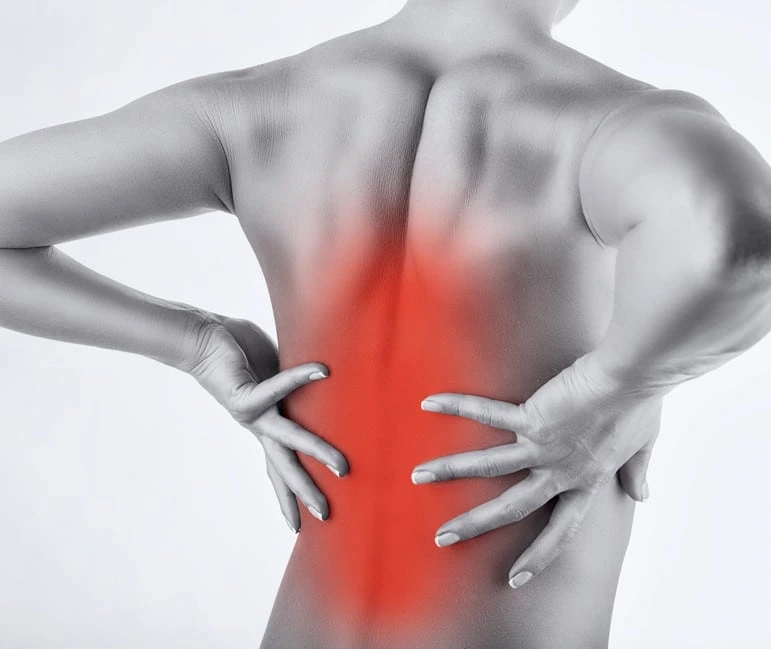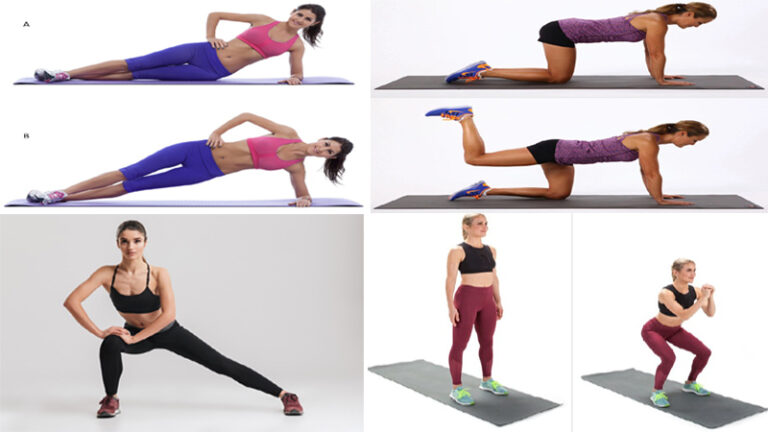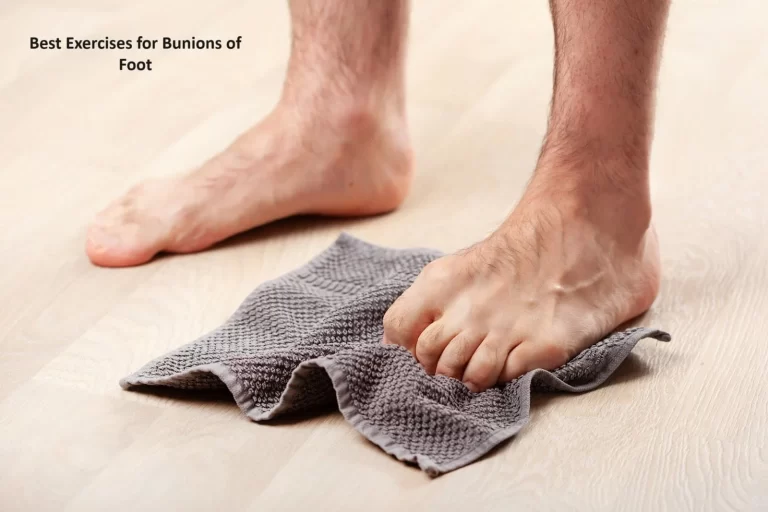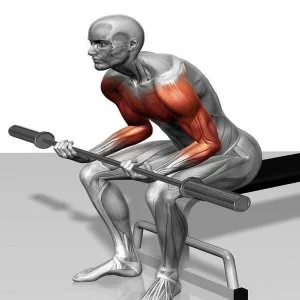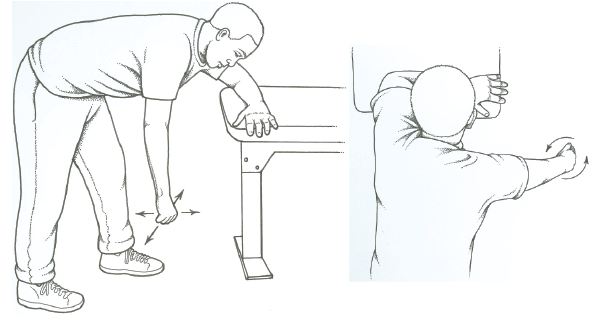How to Relieve Middle Back Pain with These 16 Easy Exercises
Middle back pain, often located between the shoulder blades, can be both discomforting and disruptive to daily life. Whether it stems from poor posture, muscle imbalances, or other factors, finding relief is essential for maintaining a healthy and active lifestyle.
While seeking medical advice for chronic or severe pain is crucial, incorporating targeted exercises into your routine can play a pivotal role in alleviating middle back discomfort. In this guide, we will explore a range of exercises designed to strengthen, stretch, and support the muscles in your middle back, ultimately helping you find relief and regain your mobility.
By incorporating these exercises into your daily routine, you can take proactive steps toward a pain-free back and improved overall well-being.
What is a Middle Back Pain?
Middle back pain can be an unpleasant condition to treat, and many people never discover its underlying reason. The middle back is a complicated region of the spine that plays an essential part in supporting the internal organs while also being prone to tenacious pain. Here are some stretches and exercises to try if you experience middle back pain. Always check with your doctor to be sure these workouts are appropriate for your specific situation.
What causes pain in the middle back?
Even while upper and middle back pain is less frequent than lower back or neck pain, it nevertheless causes a significant amount of pain. The thoracic back refers to the upper and middle portion of the back. The T1 through T12 vertebrae, a portion of the rib cage, and several muscles and ligaments that hold your spine together are all located in this region of the back.
The top and middle sections of the back, along with the rib cage, are created for support and to protect many of the most important organs of the human body, but the lower back and neck are designed to be more flexible. The middle and upper back are inherently less movable due to their rigid structure. Additionally, it indicates that treating an illness or trauma to this region of the spine may be more challenging.
Positively, there are less common issues in the middle back than there are in the lower back and neck. Rarely are disc herniation, degenerative disc disease, or spinal stenosis listed as causes of middle pain in the back.
Upper and middle back discomfort is typically brought on by overuse or an injury that results from repetitive motions or poor posture. Muscle tension can result from prolonged high stress, which can then spiral into a vicious cycle of worrying about ever-increasing discomfort that even interferes with your sleep.
Upper and middle back pain can also result from conditions that strain on the spinal nerves, such as osteoarthritis, scoliosis, or vertebral fractures.
This is particularly true for people who spend all day using a computer or who work in physically demanding and repetitive jobs (like construction and warehouse labor).
Middle back pain symptoms
Some typical signs of middle discomfort in the back include:
- the presence of both localized and widespread pain
- discomfort that starts out mildly and gets stronger over time
- some actions or postures caused pain
- varying discomfort that may be scorching, severe, or mild
Middle back discomfort may occasionally be a symptom of far more serious conditions, such as malignant tumors and illnesses of the heart, lungs, and kidneys. Make sure to see a doctor right away if you have any of the following signs or symptoms:
- Your chest, stomach, or extremities become numb or weak, the feeling of weakness occurs
- Loss of bowel or bladder control
- Chest pain or pressure
- Nausea or vomiting
- Fever
- A typical sign of a heart attack in women is upper and middle back discomfort. Contact your doctor right away if your pain comes on suddenly without any obvious injuries.
Daily tasks might become fairly difficult and limited by upper and/or middle back pain. Consider strengthening and extending the muscles in your upper and mid back that support your thoracic spine in dealing with this pain.
Practice these stretches and exercises that help with middle back pain
Press-up exercise
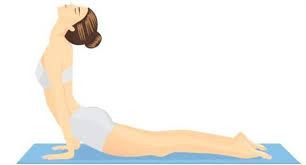
Your back extensor muscles, which are connected to the raise of your spine, are the focus of this press-up or back extension exercise.
- On your stomach, lift your shoulders with both hands.
- Keep your forearms and hips relaxed on the ground as you raise your upper body onto your elbows. Allow your chest to descend towards the floor as you exhale. Your middle back should feel relaxed and stretched.
- Hold for 5 seconds, then carefully lower yourself back to the ground.
- Try to finish 10 repeats. Build up gradually until maintain the posture for 30 seconds.
- Step 2 may be made more challenging by elevating your upper body off the ground while maintaining both hips relaxed by using your hands instead of your forearms. This posture is known as the cobra stance in yoga.
Cat-cow pose
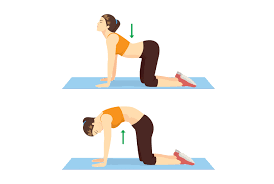
A mild stretch that might relieve your middle back discomfort is the cat-cow position.
- woman practicing the cat-cow yoga stance to relieve upper- and middle-back pain
- Get down on your hands and keep them in stance while also getting on your knees while on all fours. The neck and back need to be in a straight, neutral position.
- Slowly contract your lower abdominals while curving your back upward and tucking your chin. Your spine is supposed to feel stretched.
- Take a 5-second hold.
- Release the tension and take a neutral stance.
- Letting your spine and stomach sink towards the ground, slowly elevate your head, chest, and tailbone towards the ceiling. Your spine should feel at easely stretched as a result.
- Take a 5-second hold.
- Release the tension and take a neutral stance.
- Switch between the two positions.
Opposite arm/leg raise
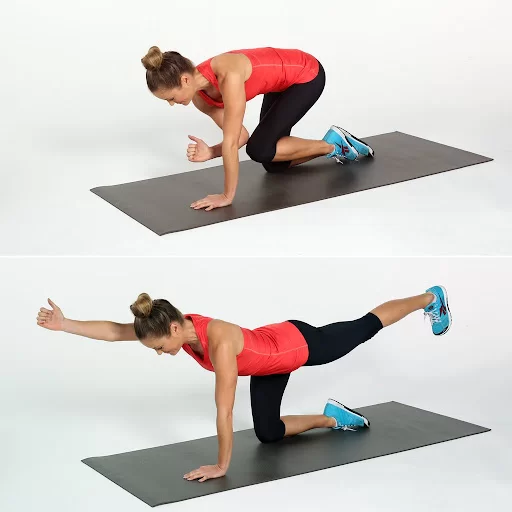
This exercise also referred to as the yoga “bird-dog pose,” tones your back and abdominal muscles.
- Woman exercising with opposing arms and legs to relieve upper and middle back pain
- Get down on your knees. Maintain a straight back, place your hands squarely below your shoulders, and place your knees exactly beneath your hips.
- Slowly extend the opposing leg while extending the arm that is closest to you. Keep your body level and straight.
- After holding for many long breaths, slowly return your arm and leg to the beginning position.
- Exercise the opposite arm or leg at the same time.
- If you were supporting a tissue box on your lower back, it need to stay there during the activity.
- For each side, try aiming for 10 to 15 repetitions.
Passive backbend
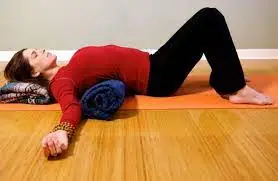
Performing a passive backbend might help you relax after a stressful day at work. If possible, maintain this position for at least three minutes. This stretch will significantly increase your back’s flexibility, alleviate stress, and enhance your posture if you incorporate it into your regular practice.
This variant makes use of household items as support, but yoga blocks are also acceptable if you have them.
- Wrap a yoga mat, blanket, or towel in a roll. Lay the rollout on the ground. Depending on the thickness of the yoga mat and the flexibility of your back, you might just want to roll a portion of it. A smaller roll gives a more gradual release whereas a larger one demands greater flexibility.
- When lying on the roll, position it so that it touches the area of your back just behind your shoulder blades. Put one yoga block under your shoulders and another under your head if you want to do a deeper variation of this backbend with yoga blocks. So that your neck feels supported, raise your head as high as necessary.
- Relax into the position, using a second blanket as a cushion for your head if required. Maintain a deep, lengthy breath.
Child’s Pose
A basic yoga stance is called the child’s pose. While the individual is supported by their knees, the spine can passively lengthen.
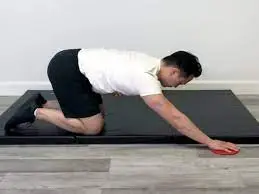
When doing the Child’s Pose:
- Get down on your knees to begin.
- Knees should be comfortably spaced apart. After that, lean forward and bring your chest to your knees.
- With the arms extended in front, if possible, bring the forehead to the floor. The arms should remain straight and the hands should softly rest on the floor.
- Rest for 20 to 30 seconds here.
- Gently raise yourself back up by using your hands.
Seated twist

Twists are a great exercise for increasing flexibility and releasing tension in the midback. According to yoga theory, twists facilitate detoxification by wringing out the internal organs.
Maintain a long spine throughout the twist by sitting up straight. Twists are intended to lengthen the spine, however, if the back is rounded, the turning motion might compress the vertebrae. Many trainees slouch down in an effort to get a deeper twist, but keeping the spine long will allow you to take advantage of all the benefits of the position.
- If possible, sit in a chair or cross your legs.
- Taking a deep breath, standing straight, and moving your left hand to your right knee, position your right hand behind you.
- As you exhale, turn your heart slightly to the right. Sense the twist releasing tension in the centre of your back as you lengthen across the spine. Feel the back opening as you concentrate on the area around your heart. By tugging on your knee or twisting too forcefully, avoid over-twisting.
- As far as your neck will allow, look over your right shoulder only. Hold for three to five breaths, then release to your center and remain there for one breath cycle.
- For the same length of time, repeat on the opposite side. If preferred, repeat both sides.
Prone cobra
An evolved back extension exercise that focuses your upper back muscles is the prone cobra:
- Lay flat on the ground. For comfort, you can rest your forehead on a hand towel that has been wrapped up.
- Put the arms at your sides with the palms facing the ground.
- Lift your hands off the ground while pinching your shoulder blades together. Keep your shoulders back and your ears aside.
- Thumbs up, palms out, and elbows rolled in.
- Do not tilt your head back and stare ahead; instead, gently elevate your forehead approximately an inch off the towel while maintaining a straight line of vision to the ground.
- Hold the posture for 10 seconds if you can.
- Try to finish 10 repeats.
- You may also raise your legs off the ground to slightly up the intensity.
Exercise should challenge your body (whether you feel stretched out or exhausted), but it shouldn’t make your symptoms worse while you’re at rest.
If any of these exercises make your discomfort worse or worsen it, stop doing them right once and talk to your doctor. An exercise regimen can be specially developed by a physiatrist, physical therapist, or other competent healthcare provider to manage your symptoms and underlying disease.
Bridge Pose
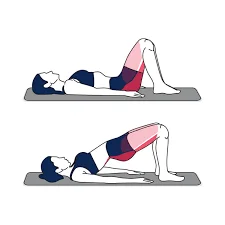
Bridge Pose, a light front body opening and back strengthener, is another. The neck is slightly strained in this position. You must not swivel your head, but keep your eyes fixed on one place on the ceiling.
- Lay flat on your back with your legs bent and your feet a few inches from your tailbone. Your heels should be reachable with your fingertips.
- So that your chest expands out slightly forward, press your shoulders into the floor and softly tuck them even farther to your back.
- Put pressure on your feet and lift your hips upward.
- Clasp your hands beneath you and raise your hips softly towards the ceiling by pushing with your feet, arms, and hands.
- Focus on the place behind your heart in your upper back, then intentionally move your chest in the direction of the wall behind you. This aids in shifting the backbend’s location from the lower back to the middle and upper back.
- After remaining for 5-7 breaths, gradually drop-down, release the hands’ grip, and bring them to rest by your side.
- Repeat three more repetitions, entering and leaving the stance slowly and thoughtfully each time.
Supported hamstring stretch
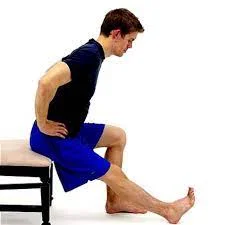
Exercises for strengthening the middle back should include stretches for the hamstrings. Try a hamstring stretch with assistance. It merely needs a chair and is gentle on the back.
Place one foot’s heel up on the seat of a strong chair while standing in front of it. Fold forward while keeping your spine long and straight and your navel in line with it by extending at the hips. Bend your knee if you have any backache. The belly of your hamstring is where you want to feel this stretch.
Take three to five deep, complete breaths, stretching your spine on each inhalation and folding it with each exhalation. Change sides. You should perform this stretch several times throughout the day.
Heart-melting pose
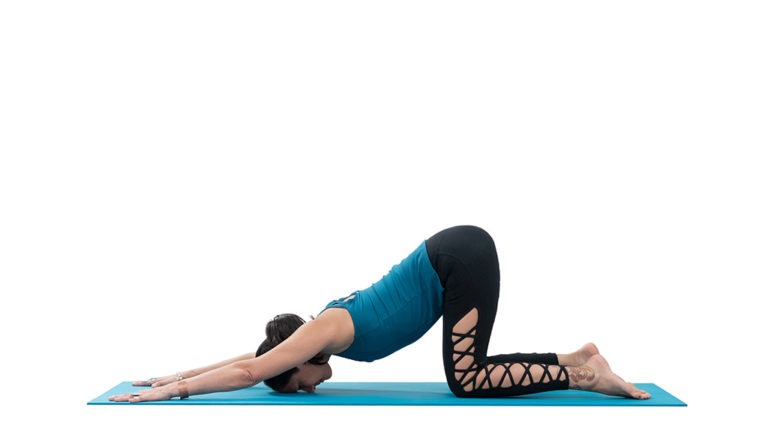
In yoga, the “heart-melting pose” is also known as the “puppy pose.” Beginning on all fours, place your hips over your knees. As you walk your hands forward to drop your forehead to the ground, keep your hips and knees in a straight line.
Keep your arms apart if the posture seems too strenuous on your shoulders. If you can’t quite reach the ground, you may also arrange a bolster or a few cushions behind your chest (along with a block underneath your forehead).
At least five breaths should be taken in this position before gently bringing your hands back to your body to exit the stretch.
Thread the needle
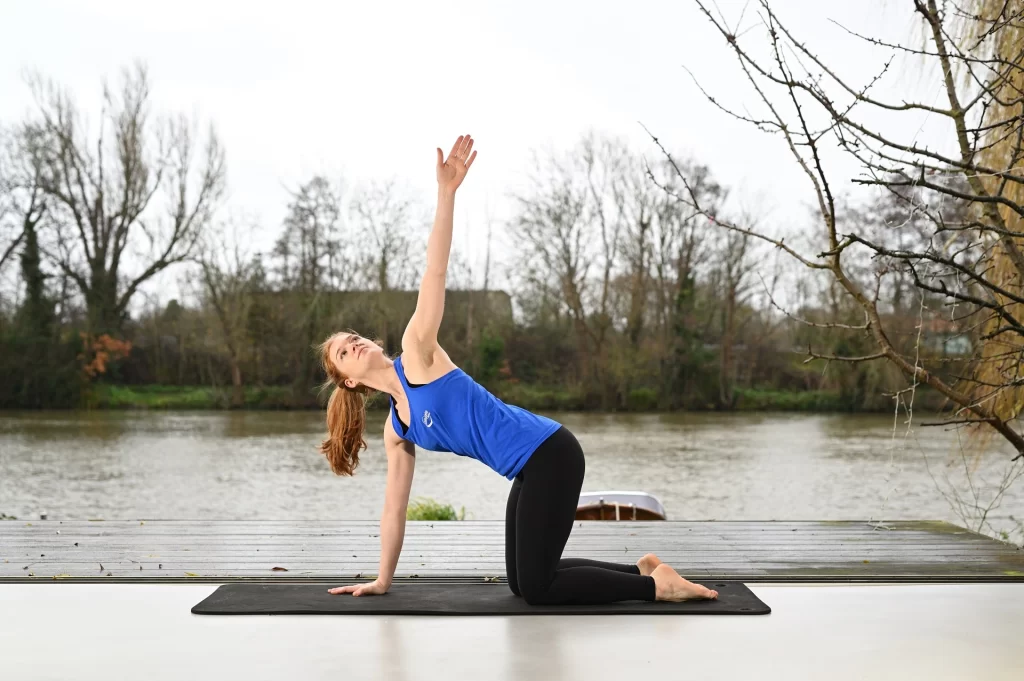
Start off on all fours with your shoulders over your wrists and your hips straight above your knees. Take a deep breath in, twist your torso to place your right hand behind your left wrist, and then lower your body until your right shoulder, right side of your face, and right arm’s back are all touching the floor. You may either extend your left hand forward or maintain it as it is. Hold this position for three to five breaths before relaxing by pressing onto your left hand.
On the opposite side, repeat.
Shoulder flossing
The shoulder blades are carefully moved through their range of motion while shoulder flossing. The same shoulder movement as in the cat and cow position is used here, but instead of keeping your lower body motionless and engaged, you should press your navel towards your spine.
- On all fours, take a deep breath and push the floor away while feeling your shoulder blades separate. Pull your shoulder blades together on your back as you exhale and lower your chest.
- Continue three or four times.
Half-dog at the wall
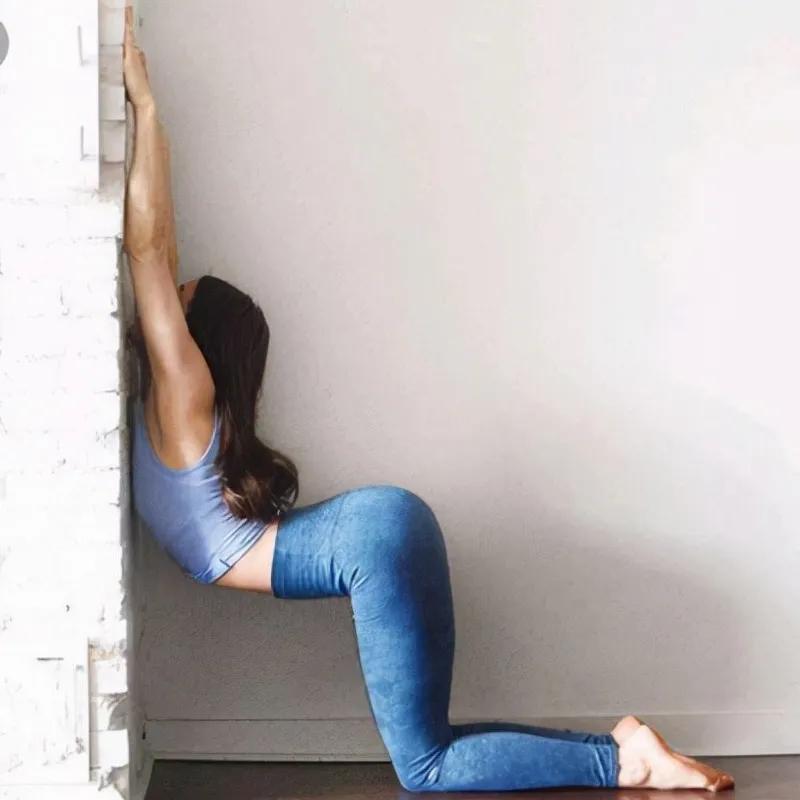
An ideal stretch for the upper and middle back that also loosens up tight hamstrings is the half-dog at the wall. Put your hands flat on the wall as you stand next to it. Walk your hands down the wall while walking your feet back to eventually form a “L” shape with your body. Bend at the hips as you do this.
Reach the crown of your head towards the wall while pulling your navel to your spine and bringing your shoulder blades together and down your back. As a result, there will be room between your shoulders and ears. Keep your tummy engaged while allowing your chest to relax towards the earth.
Bend your knees just a little if your hamstrings are tight, but make sure your hips and ankles are aligned. Here, take three to five deep breaths before gently walking your feet forward and your hands up the wall.
Resistance band pulls
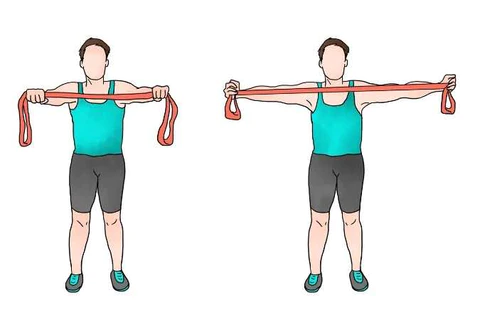
Stand with your feet parallel and your hips spaced out. Lift your arms out in front of you to shoulder height while holding a resistance band.
Stand upright and keep your navel completely engaged.
Pull your hands apart when you exhale after taking a breath. As your hands split, squeeze your shoulder blades together, and then gradually release to return to the center. As you grow stronger, increase the number of repetitions or move your hands closer together for three sets of three repetitions to five.
Dumbbell row
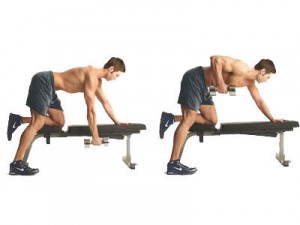
On all fours, in a chair or bench, or without any support at all.
Starting on all fours, hold a dumbbell in each hand. Pull your navel in to support your lower back. Slowly raise your elbow while taking a breath in order to bring the dumbbell in your right hand near your armpit. Keep your arm firmly in place next to your torso.
When rowing on the right side while utilizing a bench, keep your right leg on the ground and your left knee and hand on the bench. Start with one set and work your way up to three rows, aiming for five to seven.
High plank dumbbell row
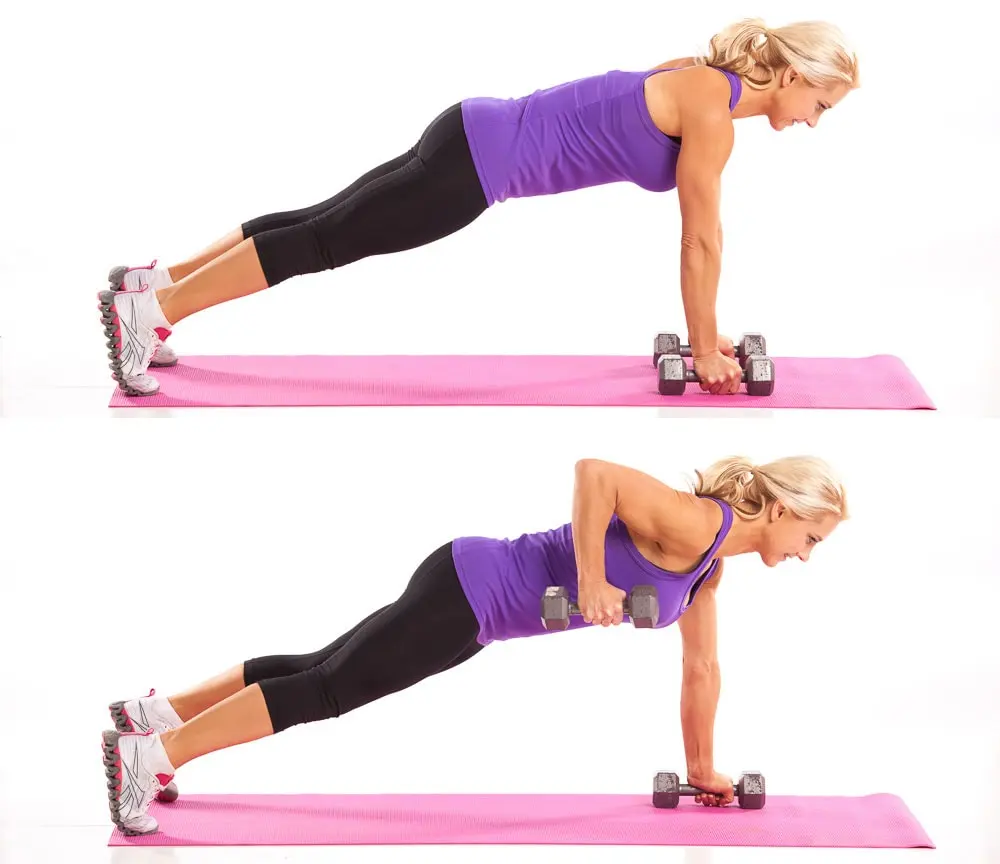
This motion is perfect for you if you want to incorporate a core-strengthening exercise, a cardio workout, and muscle-strengthening all into one low-impact exercise.
Instead of placing your hands on the ground, come into a high plank with them around dumbbells. Ensure that your hips and shoulders are in alignment. To protect your lower back, lift your navel upward.
Bend your elbow and bring the right dumbbell to your armpit (as in the dumbbell row) while moving on either an inhale or an exhale, depending on which feels most natural to you. As you switch sides, remember to keep your heels pointed back and your head and crown forward in the ideal plank position.
Finish three to five reps on each side, take a break, then attempt another set. Again, gradually increase the weight or the repetitions, one at a time.
Tips for managing Middle Back Pain
In addition to stretching, there are additional straightforward actions that might lessen or prevent pain from recurring, including:
- staying mobile
- medication
- complementary therapies
- posture correction
- Directed workout styles like Pilates and yoga
The stability and general health of the back can be enhanced by strengthening the muscles that run the length of the back.
Overview
Middle back discomfort can result from a number of lifestyle choices, illnesses, and injuries.
The frequent occurrence of pain in the back can have a negative impact on one’s overall health and well-being. Regular middle back stretches can assist to relax and strengthen muscles, which can help to improve posture and lessen back discomfort.
FAQs
What is middle back pain a symptom of?
There are further spinal-related reasons for middle back discomfort. This includes disc degeneration, rupture, herniation, spinal arthritis, and spinal stenosis (narrowing of the spinal canal). Middle back discomfort can also result from osteoporosis or weakening bones.
Will middle back pain go away?
Recovery. Acute middle back pain often disappears on its own within a few weeks. However everyone experiences pain differently, and back pain is a somewhat complicated condition.
Which technique relieves back pain the quickest?
One of the fastest methods to effectively treat back pain is via exercise. Try yoga, walking, or swimming.
What is the most typical reason for discomfort in the middle back?
injuries such as sprains and strains
Several cases of upper and middle back pain are brought on by outside factors like muscular strain and tension throughout which can put strain on the discs, ligaments, and muscles. Poor lifting technique, bad posture, or overusing the muscles can all cause discomfort.
Can massage help with middle back pain?
If the pain in your back is being caused by something like muscle tension or strain, massage treatment can help. The first indication of arthritis is joint inflammation. Body stiffness and discomfort are symptoms of fibromyalgia.
Is yoga good for middle back pain?
One of the most typical kinds of back pain is lower back discomfort. But there is a growing tendency in back pain—middle back pain—in the age of texting and practically constant computer use. Yoga is a safe and simple approach to help ease pain and stress, which is fortunate for those with middle back problems.
References
- 5 Exercises for Upper and Middle Back Pain. Spine-health. https://www.spine-health.com/blog/exercises-upper-and-middle-back-pain
- 11 Stretches And Workouts For Center Of The Back Ache | Arizona Pain. https://arizonapain.com/middle-back-pain-exercises/
- 5 Stretches for Your Mid Back to Relax and Relieve Stiffness. Healthline. https://www.healthline.com/health/fitness-exercise/mid-back-stretches
- 8 stretches for the middle back. https://www.medicalnewstoday.com/articles/323813

